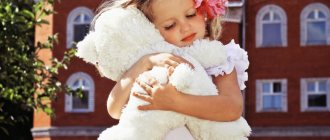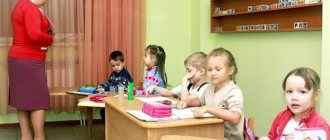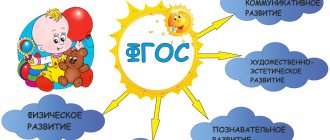Class:
2
Target
: consolidation of knowledge about vowels of the 2nd row, their functions of softness of the consonant in front.
Tasks
:
- consolidate knowledge about the importance of row 2 vowels to indicate the softness of sound.
- practice finding and naming hard and soft consonants in syllables and words.
- correct the work of the visual-auditory analyzer in exercises to identify the vowels of the 2nd row and the soft consonants that precede them.
- develop thinking and attention when working with sentences and text.
- promote the formation of coherent, expressive speech.
- continue to develop learning skills and self-control skills.
Material
: table of sound symbols for row 2 vowels (I - ya, E - yo, E - ye, Yu - yu); table with vowel letters 1 and 2 rows in pairs (A-Z, O-E, E-E, U-Y, s-I); cards with words (rad - row; nose - carried; bow - hatch; soap - mil); hourglass; signs “+”, “-”, “tick”.
For each child: lined notebooks; cards with syllables, words, text; pencils (red, blue, green); “fives”.
Progress of the lesson
“Roll call” - the one who identifies himself by name sits down.
What vowels did we talk about in the last lesson? (Vowels of the 1st row: A, O, U, E, y) How did we pronounce them? (Stretched and sang) What consonants come before these vowels (Hard) Remember and name the syllables with vowels of the 1st row.
The speech therapist teacher announces the topic of the lesson: “Vowels of the 2nd row”; The purpose of the lesson is to consolidate knowledge about the vowels of row 2, their influence on the consonant in front of them, and about one of the ways to soften consonants.
Vowels of row 2 consist of two sounds (a table with sounds is shown). We will agree that we will not make these sounds like small, stupid donkeys. We will call the vowels of row 2 briefly and clearly: “I, E, E, Yu.” (The teacher-speech therapist calls, then the children.) Which vowel from row 2 can you stretch out and even sing? (Vowel “I”).
A table with vowels of rows 1 and 2 is entered. Children name the vowels of row 1, stretching them out, and rows 2 - briefly and clearly. Then the speech therapist teacher reads a poem, the children name the vowels in pairs. Once again, attention is drawn to the fact that children call the vowels of row 2 “Ya, E, E, Yu” briefly, clearly, without prolonging them.
- We call the letter “A”, and the friend’s letter is “I”,
- Let’s draw the letter “O” with you, and the friend’s letter is “E”,
- The letter “U” sang a song, and “Y” answered it,
- We sang the letter “E”, and in response we hear “E”,
- And with the baby the letter “y” sings the song “I”.
Work in notebooks.
Remind children about posture when completing tasks in their notebooks.
The speech therapist teacher shows cards with words written in pairs (rad - row; nose - carried; bow - hatch; soap - mil), suggests listening to two words on the first card; set their meaning; determine the nature of the sound of consonants; clarify that the 2nd row vowel is used to indicate the softness of consonants.
I'll say two words, and you think about how they differ: glad - row.
What is rad? What is a row? This means that these words have different meanings.
And what else? What do the first consonants sound like? “RAD” (pause)…..firmly. Name the sound (“P”). Let's write this word down. Read what happened: …….HAPPY. (Vowels, hard and soft letters are highlighted in color. It is specified that red is used to indicate vowels, hard consonants are blue, soft consonants are green.)
And now we need: “ROW”. Name the first sound (“Рь”). After “Рь” we will write the letter……. "I". Let's write this word down. Read what happened: ……. "ROW".
In our word “row”, the vowel of row 2 “ya” serves……… to soften the sound “R”.
Work with pairs of words “nose - carried” is carried out in a similar way; bow - hatch; soap - nice.” Children come up with sentences using these words.
What are the vowels of row 2 used for? (Vowels of row 2 are needed to soften the consonant that comes before it).
There are two ways to indicate soft consonants in writing. The first method: using the vowels of the second row “i, e, e, yu, i”. The second one is ?…….. We will talk about it in the next lessons.
Game exercise “Captains”. Children perform movements only if the speech therapist gives the command “Captains”. (For example, “Captains, clapped your hands!” - performed; “Stamped your feet!” - no, etc.)
Tasks on cards.
No. 1 GA, GYA, RO, RE, NYA, NA, ZY, LA, SI, TYU, PO, FY, VE, DIA, BYU, WE, SHU, SA, HI, DU, NYA, BE, RY, PYU, CO.
No. 2 SLEDGE, REBUS, CIRCLES, CRANBERRY, SPOTS, DRIVER, BUCKETS, GRAINS, HOOK, LITERS
No. 3 Friends.
Kolya is sick. He lay in bed and looked out the window. Suddenly he saw a green ball. There was a face drawn on the balloon. Kolya guessed that the guys had come up with this idea. Then Lyuba, Seryozha and Tima came. They brought a book with pictures. Kolya felt good.
Task No. 1. Reading syllables, circling syllables only with vowels of the 2nd row, softening the consonants in front of them.
Speech material: ga, GYA, ro, RE, NYA, na, sy, LA, SI, TYU, po, fy, VE, DYA, BYU, we, shu, for, HI, so, NYA, BE, ry, PU , ky.
Children name syllables with soft consonants. The speech therapist teacher repeatedly names the syllables, the children - a vowel of the 2nd row and a soft consonant in a syllable.
Then the children put a “+” sign if they liked the task and completed it easily; “-” sign if it was difficult or you didn’t like the task; “check” if not everything worked out, there were errors.
Oral task: the teacher-speech therapist names words, and children name syllables with vowels of the 2nd row and soft consonants standing in front of them: RU-KI, MUSHROOMS, MARK-KI, DOS-KA - !, KLYAK-SA, TABLE - !, TOF-LI, YU-LA -!, KOS-TER, RAIN-DI, YAB-LO-NYA, ZEB-RA, ZON-TIK, SWEK-LA.
To develop attention and thinking, children are given “provocative” variants of words (there is a vowel of the 2nd row, but there is no consonant in front of it; there are no vowels of the 2nd row and soft consonants).
After completing the task, children put “+”, “-” or a tick on the cards.
Task No. 2:
write down 5 words syllable by syllable, circle the vowels of row 2 in red, highlight the soft consonants that precede them in green.
LEAD, REBUS, CIRCLES, CRANBERRY, STAINS, DRIVER, BUCKETS, GRAINS, HOOK, LITERS.
After completing the task, children put “+”, “-” signs or a tick.
Physical education minute.
- Option 1: children perform voluntary movements to cheerful music.
- Option 2: children perform movements in accordance with the text, pronouncing words.
We stomp - stomp with our feet, clap - clap with our hands! We are the eyes of a moment - a moment, We are the shoulders of the chick - chick. One here, two there, turn around. Once - they sat down, twice - they stood up. Everyone raised their hands up. One - two, one - two, it's time for us to get busy!
Task No. 3. Working with text:
Expressive reading of the text by a speech therapist teacher, children determining the number of sentences, words in sentences (paying attention to “small” words - prepositions);
Reading the text by children (you can offer reading one sentence at a time - “in a chain”, at the choice of the reading student by the speech therapist teacher);
Reading sentences proposed by the speech therapist or chosen by the students themselves with different intonations.
Attention exercise: children find 2 rows of vowels in the text, circle them in red (you can suggest highlighting the soft consonants before the vowels with a green pencil). The teacher uses an hourglass so that the children can control the time they complete the task.
Kolya is sick. (2) He lay in bed and looked out the window. (8) Suddenly he saw a green ball. (5) A face was drawn on the ball. (5) Kolya guessed that the guys had come up with this idea. (6) Then Lyuba, Seryozha and Tima came. (6) They brought a book with pictures. (5) Kolya felt good. (3)
After completing the task, the children exchange cards, check each other’s assignments, then put “+”, “-” or a tick on their cards.
Summary of the lesson.
What are row 2 vowels needed for? (Vowels of row 2 are needed to soften the consonant that comes before them.)
How did we agree to call the vowels of row 2? (Shortly, clearly, without drawing out)
What tasks did you find difficult? Can you say that you did a good job today? Why?
Children receive “A” grades for diligence and active work in class.
After the lesson, when checking the completion of tasks by children and the signs they put down (“+”, “-”, “tick”), the speech therapist teacher analyzes the level of development of control and self-control skills.
Speech therapy session
with 2nd grade students who have writing and reading impairments due to undeveloped skills of analysis and synthesis
Topic:
Vowel letters of the 1st and 2nd series.
Purpose:
to clarify the similarities and differences between the vowels of the 1st and 2nd rows.
Objectives:
1) introduce the sound composition of vowel letters of the 2nd row;
2) develop phonemic awareness; 3) develop skills in language analysis and synthesis; 4) learn to draw conclusions, listen and understand others; 5) develop memory, attention and thinking. Progress of the lesson.
1. Organizational moment.
-Today we are going to the Land of Sounds. What can you go on a trip with? (example children's answers: by car, bus, plane, etc.) And we will travel in a hot air balloon. In order for the ball to rise into the air, we must perform exercises (performing brain gymnastics): - “Lazy figure eight” (draw a lying figure eight in the air with your left hand, then with your right, then with both). - “Cross movements” (touching the opposite knee or foot with the hand or elbow) - “Ring” (with the fingers of the right hand, then with the left, together). 2. Repetition. - So, we flew to the land of sounds. To land, we need to answer the questions: - What two groups are all sounds in the Russian language divided into? (vowels and consonants) - What sounds are pronounced without an obstacle? (denoted in red). - Which ones have an obstacle? (denoted by blue or green). —What is the difference between a sound and a letter? We pronounce the sounds clearly, we listen carefully, we read the letters correctly, we write them carefully. 3. Explanation of a new topic. The speech therapist tells a fairy tale. At the same time, records are kept in notebooks and used). - So, a ball has been announced in the Land of Sounds. Sounds gathered in different halls. In one, consonants are fun, and in the other, vowels are fun. Remember what vowel sounds there are. On the left in the column we write down the vowel sounds [a], [o], [u] [e] [s].
Only
[and]
decided to stand aside (in the right column at level
[s]
).
The vowel sounds were a bit boring because there weren't many of them. [th]
noticed this and decided to cheer them up (give a description of the sound
[th]
- consonant, sonorous, soft).
[Y]
[a]
to dance (record
[ya]
YAYAYAYA
.
The result is the letter I
(entry in the right column
[ya] = I).
[Y]
[o]
to dance (record
[yo]
).
They began to spin faster and faster, and all the guests heard YOOYYYYYYYYYYYYYYYYYYYYYYYYYYYYYYYYYYYYYYYYYYYYYYYYYYYYYYYYYYYYYYYYYYYYYYYYYYYYYYYYYYYYYYYYYYYYYYYYYYYYYYYYYYYYYYYYYYO by
.
The result is the letter E
(entry in the right column
[yo] = e).
[Y]
[u]
to dance (record
[yu]
).
They began to spin faster and faster, and all the guests heard YUYYYYYYYYYYYYYYYYYYYYYYYYYYYYYYYYYYYYYYYYYYYYYYYYYYYYYYYYYYYYYYYYYYYYYYYYYYYYYYYYYYYYYYYYYYYYYYYYYYYYYYYYYYYYYYYYYYYYYYYYYYYYYYYYYYYYYYYYYYYYYYYYYEYYYYYYYYYYYYYYYYYY
\YYYY...
The result is the letter Yu
(entry in the right column
[yu] = yu).
[Y]
invited the sound
[e]
(record
[ye]
).
They began to spin faster and faster, and all the guests heard EEEEE
.
The result is the letter E
(entry in the right column
[е] = e).
But dance with sound [and]
it didn’t work out, and he was left alone (
[and] = and).
The sounds
[ya]
are denoted by the
letter
I. When we read the letter I,
we hear two sounds.
The sounds [yo]
are
denoted by the letter
E. When we read the letter E,
we hear two sounds.
The sounds [yu]
are denoted by the letter
Yu
.
When we read the letter Y,
we hear two sounds.
The letters Ya, Yo, Yu, E, I are vowels in 2 rows. The sounds [a], [o], [y] [e] [s]
are also denoted by letters (writing
[a]= a, [o]= o, [y]= y,
[e]= e,
[s]= s).
The letters A, O, U. E, Y are vowels of the 1st row.
4. Physical education minute. We stomp-stomp with our feet, (stomp) We clap-clap with our hands, (clap) We blink-blink with our eyes, (blink) We chick-chick with our shoulders! (shrug our shoulders) Once we sat down, twice we stood up, (corresponding movements) They all raised their hands up, They all pressed their hands to the body, And they began to do jumps. One-two, one-two It’s time for us to get busy. 5. Development of phonemic awareness. The vowels have prepared tasks for us. 1 task
.
Write down the first letter of the words. What sound does the vowel make? Stork, cucumber, dill, spinning top, turkey, anchor, hedgehog, excavator, blackberry.
Entry in notebooks: [a] [o] [y] [yu] [i] ya] [yo] [e] [ye] A O U Y I I Y E E E
2 task
.
Game "Say the opposite". The speech therapist throws the ball and pronounces the syllable MA. The child must answer ME and return the ball. — Write the syllables in pairs with vowels of the 1st and 2nd rows (MA-MYA). - Read the syllables of the first column. What does a consonant sound like? (firmly). Vowels of the first row give the command to consonants to be firm.
Underline the consonants with a specific color (blue).
- Read the syllables of the second column. What does the consonant sound like? (soft). Vowels of the second row give the command to consonants to be soft.
Underline the consonants with a specific color (green).
6. Warm up for the eyes. - Close your eyes tightly for 3-5 seconds (repeat 5 times); - Blink quickly; - Follow the index finger moving towards the nose, then move the finger away. 7. Development of sound-letter analysis and synthesis. The vowels want to play with us. The first game "Settle into the house."
Each item must live in its own house.
For example: words where the letter A
move into a hut with the letter
A
, etc.
Entry in notebooks: A - bow, ball. U - goose, beetle. O - wolf, elephant. Y – cheese, mouse. Second
game
"Drive
gates".
Place these vowels between the letters M and L. - What words did you get? (small, crumpled, chalk, chalk, mule). Read the poem, filling in the missing words. Compare words by meaning and pronunciation. Write down the sound analysis of the words (small - [m,al]). - Come up with sentences with these words. Write down one of them (My brother is too small.) 8. Summary of the lesson. - Name the vowels of the 1st row, the vowels of the 2nd row. — How many vowel sounds are there in the Russian language? How many letters? — Help me complete the sentences: If the consonant sounds hard, then we write... If the consonant sounds soft, then we write... Well done! Now vowel letters will always be friends with us. And this is where our journey comes to an end. We return to class. 9. Relaxation. — If you liked the lesson and everything was clear, draw an emoticon with a smile. — If something remains unclear, then we draw a serious emoticon, and if we didn’t like it and didn’t understand much, then we draw a sad emoticon.
Goals:








